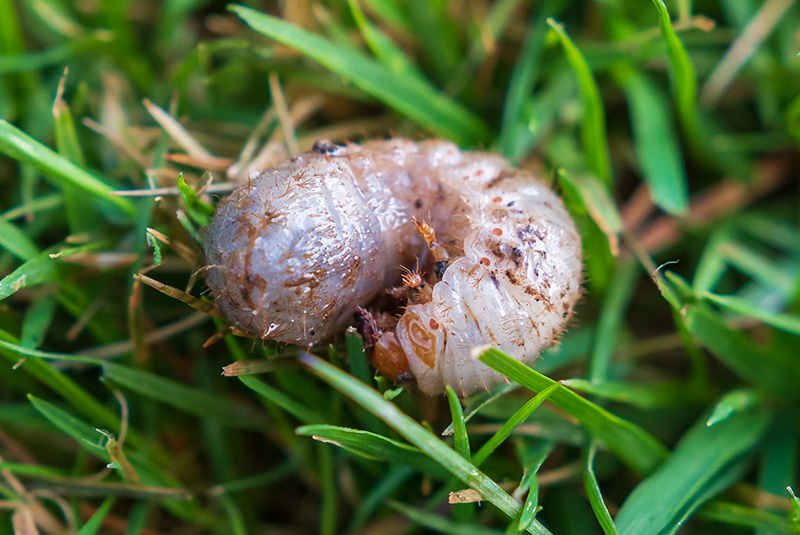With a mild winter and a wet spring, we’ll need to be ready to combat an uptick of grub and insect infestations. We know that prevention and early control, whether for weeds or insects, is key to making sure your customers lawns look good all season long. However, with a delay to the start of the season because of COVID-19 in many areas of the country, what can you do if you missed that early control window?
We’ve asked Bob Hartman, Central’s Turf Director, to discuss the most effective solutions available for insect control, both surface and subsurface.
From Bob:
“What type of insect control would be best for me?”
This is a commonly asked question but the answer is not always so clear or straight to the point. You first have to define what type of problem or pest you have. It can be a surface insect or perhaps ones you don’t see, that are underground, which we call subsurface insects.
Once you have determined the type of insect problem you have, you now need to understand that particular insect’s life cycle and what stage of that life cycle it is in. Some products kill the eggs of an insect, some the larva, nymph, pupa stage and some at full adult stage. Application timing and the “mode of action” are critical when trying to optimize the control of the insect.
It is important that you always follow the pesticide label anytime you apply a pesticide. You also want to make sure you are conforming to local, state, and federal laws as well.
Grubs & Subsurface Insects
Grubs are nasty subsurface pests that can destroy a lawn or a golf course in no time. Common signs that depict grub damage in your turf are wilting blades, brown spots, and dying and dead grass patches. This damaged turf can be lifted very easily and you be able to see the grubs. If you see skunks, crows or moles feeding in your lawn, more than likely they are looking for and have found grubs. One way to treat grubs in a preventative fashion is with a product known as Chlorantraniliprole or goes by the brand name Acelepryn.
I mention the Chlorantraniliprole active ingredient first because it will control both surface and subsurface insects, all season long. The other benefit is you can apply this product in early spring when the ground and air temperatures are still cool without sacrificing efficacy. It is a very low impact control on non-target organisms and has a much broader application window than other active ingredients. Acelepryn can be applied as a liquid and as a granular to turf which makes it a very versatile product.
Another active ingredient that will kill grubs is Imidacloprid. It can also go by the brand names Merit and Mallet. It is a systemic insecticide that acts as a neurotoxin which impacts the central nervous system of insects. This insecticide is definitely more toxic to insects than mammals. When applied in June and July, they provide excellent protection against the next generation of grubs. Imidacloprid is considered a preventative product. The one drawback to Imidacloprid is the fact that it is considered a neonicotinoid. It can have a negative impact on our honeybee population, so it is best to always apply according to the label and federal, state, and local regulations.
If you are looking for curative active ingredients to kill grubs, look no further than carbaryl or trichlorfon, or better known by the brand name Dylox. The ideal timing for this product is Mid-August to mid to late September. One benefit to this active ingredient is you will also get control of ants, ticks and other insects.
Surface Insects
When it comes to treating surface insects, there are a myriad of products available. One of my favorites is Bifenthrin and sometimes goes by the brand name Talstar, Baseline, Captive, and Discipline. It controls the following surface insects specifically: termites, ants, beetles, chinch bugs, crane flies, crickets, fleas, Japanese beetles, mole crickets, ticks, and sod webworms. Bifenthrin works on contact and by ingestion to paralyze the insect, causing death within minutes or hours. It can be used both outdoors and indoors. Plants cannot absorb Bifenthrin, so it’s safe to use around ornamentals and turf. It is relatively safe to use around humans and pets once it has dried on the target surface.
Remember, you always have many options at your disposal to take care of unwanted pests in the lawn and landscape. Understanding the target pest, the life cycle of the pest, and the proper method for controlling that pest is the best approach. Then pick the right mode of action and active ingredient to achieve your desired result. Not sure what to use and when? Contact your local Central representative for all your expert help.
Finally, rely on Central to help, whether it’s questions about the newest innovations in agronomics, organic & low-impact programs, or finding the right solutions for a problem area. We stay at the leading edge of the industry and we’re ready to help you grow!
About Bob Hartman
Bob Hartman is an industry veteran with more than 15 years of experience in the green industry; specifically, turf. Bob brings a solid background in both the organic and synthetic methods of feeding turf and plants. His diverse background and experience on the manufacturing makes him an excellent resource to help you grow your business.

